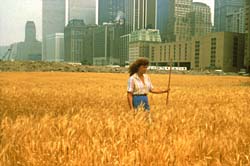
'Green Horizons,' Bates' summer exhibition, examines sustainability
With its centerpiece a giant painting that depicts Brooklyn after millennia of global warming, an exhibition exploring the concept of environmental sustainability opens on June 9 at the Bates College Museum of Art, 75 Russell St.
Green Horizons will present prominent artists from Maine and the world in an adventurous attempt to provoke conversations around the questions: What is green? What is sustainable?
This dynamic project will transcend traditional exhibition practices to include collaborations with writers and choreographers — including participants in the renowned Bates Dance Festival — and will reach outside the museum walls to site-specific works such as a fruit orchard to be planted in downtown Lewiston.
Sponsors of the exhibition, which closes Dec. 9, include the Synergy Fund, the Maine Arts Commission and the LEF Foundation. Admission to the exhibition and to museum events is open to the public at no cost.
For more information, please call 207-786-6158 or visit the museum’s Web site.
In addition to Alexis Rockman, whose 8-by-24-foot painting Manifest Destiny depicts Brooklyn under water and has been exhibited nationwide, Green Horizons participants include internationally renowned environmental artists Agnes Denes, Chris Jordan and David Maisel; such Maine artists as photographer Mark Silber, hay sculptor Michael Shaughnessy and the agitprop Beehive Design Collective; and commissioned collaborative works involving visual artists, Bates faculty and students. (See a condensed list or a detailed list of exhibit participants.)
“We’re not trying to define sustainability,” explains museum director Mark Bessire. “We’re trying to ask what it means.”
“The word seems to be overused — used for marketing, to convince people of things, to make people feel better. There’s a certain amount of hypocrisy connected to its use,” he explains. “So we wanted to bring forth works of art that questioned sustainability and created a conversation among the many disciplines of a liberal arts college.”
“Rather than us having a very defined vision and going out and making that, it’s been us talking to people about our idea and having them help us determine what vision is appropriate,” adds Anthony Shostak, the exhibition’s curator and the museum’s education curator.
Here are a few examples from the exhibition:
— Images of two of Denes’ land reclamation projects, including Wheatfield — A Confrontation, for which the artist grew wheat on a site in New York City;
— Jordan’s strangely beautiful renderings of high-tech waste products, such as discarded cell phones;
— A project in which Swiss artist Anne-Katrin Spiess will document the steps she must take to render her Maine visit carbon-neutral;
— An initiative to raise awareness about trees, produced by two Bates students in collaboration with the local nonprofit Lots to Gardens, that will involve the planting of fruit trees in downtown Lewiston;
— In Sustainable Wardrobe, clothing made by a Bates student from locally produced fibers and recycled natural fabrics.
— A public art project along the Androscoggin River exploring themes of community history and place-making, organized by the college’s Harward Center for Community Partnerships and a Boston sculptor;
— A performance project set at Bates’ Lake Andrews and created collaboratively by the Bates Dance Festival, the acclaimed PearsonWidrig DanceTheater and composer Robert Een.
“When people walk into this show, we definitely want to have this more cluttered nonlinear feeling,” says Bessire. “It’s going to be a huge painting, a huge garbage heap, a bicycle trying to create energy, a huge sculpture of hay, massive photographs.”
“It’s going to be messy.”
The $2 million Synergy Fund, created at Bates by donor Lee Smith, has provided major support for Green Horizons. The fund, Bessire explains, is designed to use visual culture as a catalyst for productive and probing exchanges between academic disciplines and between campus and community. While Synergy has supported other museum projects, he notes, “Green Horizons is the first major exhibition made possible by the Synergy Fund to examine its topic in such depth and breadth.’ ”







